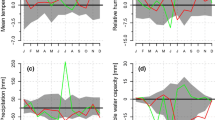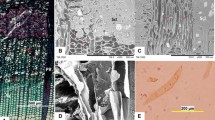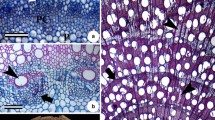Abstract
The cambial activity and periodicity of secondary xylem and phloem formation have been less studied in tropical tree species than in temperate ones. This paper describes the relationship between seasonal cambial activity, xylem and phloem development, and phenology in Schizolobium parahyba, a fast growing semideciduous seasonal forest tree from southeastern Brazil. From 2002 to 2003, wood samples were collected periodically and phenology and climate were recorded monthly in the same period. S. parahyba forms annual growth increments in wood, delimited by narrow initial parenchyma bands. The reduction of the cambial activity to a minimum correlates to the dry season and leaf fall. The higher cambial activity correlates to the wet season and the presence of mature leaves. In phloem, a larger conductive region was observed in the wet season, when the trees were in full foliage. The secondary phloem did not exhibit any incremental zone marker; however, we found that the axial parenchyma tends to form irregular bands.






Similar content being viewed by others
References
Ajmal S, Iqbal M (1987) Annual rhythm of cambial activity in Streblus asper. IAWA Bull 8:275–283
Antonova GF, Stasova VV (2006) Seasonal development of phloem in scots pine stems. Russ J Dev Biol 37:306–320
Bennet HS (1976) Science and art in preparing tissues embedded in plastic for light microscopy, with special reference to glycol methacrylate, glass knives and simple stains. Stain Technol 55:71–97
Berlyn GP, Miksche JP (1976) Botanical microtechnique and cytochemistry. The Iowa State University Press, Ames
Carvalho PER (1994) Espécies florestais brasileiras: recomendações silviculturais, potencialidades e usos da madeira. Embrapa-CNPF, Paraná, Colombo
Dave YS, Rao KS (1982) Seasonal activity of the vascular cambium in Gmelina arborea Roxb. IAWA Bull 3:59–65
Deshpande BP, Rajendrababu T (1985) Seasonal changes in the structure of the secondary phloem of Grewia tiliaefolia a deciduous tree from India. Ann Bot 56:61–71
Eckstein D, Saas U, Baas P (1995) Growth periodicity in tropical trees. In: Proceedings of internal meeting, Kuala Lumpur, Malaysia, November 1994. IAWA J 16, 120 p
Esau K (1967) Plant anatomy, 2nd edn. Wiley, New York
Evans DE (2003) Aerenchyma formation. New Phytol 161:35–49
Evert RF (1990) Dicotyledons. In: Behnke HD, Sjolund RD (eds) Sieve elements: comparative structure, induction and development. Springer, New York
Ferreirinha MP (1958) Elementos de anatomia de madeiras folhosas portuguesas. Memórias da Junta de Investigações do Ultramar, 3, segunda série, Lisboa
Gerlach D (1984) Botanische Mikrotechnik. Georg Thieme Verlag, Stuttgart
Ghouse AKM, Hashmi S (1979) Cambium periodicity in Polyalthia longifolia. Phytomorphology 29:64–67
Ghouse AKM, Hashmi S (1980a) Seasonal production of secondary phloem and its longevity in Mimusops elengi L. Flora 170:175–179
Ghouse AKM, Hashmi S (1980b) Longevity of secondary phloem in Delonix regia Rafin. Proc Indian Acad Sci 89:67–72
Héband C (1969) Observations sur le phloème de quelques Filicinées tropicales. Nat Monspel Ser Bot 20:135–196
Iqbal M, Ghouse AKM (1987) Anatomy of the vascular cambium of Acacia nilotica (L.) Del. var. telia Troup (Mimosaceae) in relation to age and season. Bot J Linn Soc 94:385–397
Jacoby GC (1989) Overview of tree-ring analysis in tropical regions. In: Baas P, Vetter RE (eds) Increment zones in tropical woods. IAWA Bull 10:99–108
Johansen DA (1940) Plant microtechnique. McGraw-Hill, New York
Joly AB, Teixeira C (1958) Observações sobre a anatomia da casca do guapuruvu, Schizolobium parahyba (Vell.) Blake. Bol Fac Filos Ciências e Letras da Univ de São Paulo 224:81–100
Justin SHFW, Armstrong W (1987) The anatomical characteristics of roots and plant response to soil flooding. New Phytol 106:465–495
Kozlowski TT, Kramer PJ, Pallardy SG (1991) The physiological ecology of woody plants. Harcourt Brace Jovanovich, London
Machado SR, Marcati CR, Morretes BL, Angyalossy V (2005) Comparative bark anatomy of root and stem in Styrax camporum (Styracaceae). IAWA J 26:477–487
Mainieri C, Chimelo JP (1989) Fichas de características das madeiras brasileiras. Instituto de Pesquisas Tecnológicas, IPT, São Paulo
Marcati CR, Milanez CRD, Longo LR, Angyalossy V (2004) Seasonal variation in wood formation of some Brazilian tropical and subtropical species. Proceedings of international symposium on wood sciences, Montpellier, p 41
Marcati CR, Angyalossy V (2005) Seasonal presence of acicular calcium oxalate crystals in the cambial zone of Citharexylum myrianthum (Verbenaceae). IAWA J 26:93–98
Marcati CR, Angyalossy V, Evert RF (2006) Seasonal variation in wood formation of Cedrela fissilis (Meliaceae). IAWA J 27:199–211
O’Brien TP, McCully ME (1981) The study of plant structure: principles and selected methods. Termarcarphy PTY, Melbourne
O’Brien TP, Feder N, McCully ME (1964) Polychromatic staining of plant cell walls by toluidine blue O. Protoplasma 59:368–373
Priya PB, Bhat KM (1999) Influence of rainfall, irrigation and age on the growth periodicity and wood structure in teak (Tectona grandis). IAWA J 20:181–192
Rajput KS, Rao KS (1998) Seasonal anatomy of secondary phloem of teak (Tectona grandis L. Verbenaceae) growing in dry and moist deciduous forests. Phyton 38:251–258
Rajput KS, Rao KS (2001) Cambial activity and development of xylem in Tamarindus indica L. growing in different forests of Gujarat State. Acta Bot Hung 43:379–390
Rao KS, Rajput KS (1999) Seasonal behaviour of vascular cambium in teak (Tectona grandis) growing in moist deciduous and dry deciduous forests. IAWA J 20:85–93
Rao KS, Rajput KS (2000) Cambial activity and development of wood in Acacia nilotica (L.) Del. growing in different forest of Gujarat State. Flora 165–171
Rao KS, Rajput KS (2001) Relationship between seasonal cambial activity, development of xylem and phenology in Azadirachta indica growing in different forests of Gujarat State. Ann For Sci 58:691–698
Saas JE (1951) Botanical microtechnique. The Iowa State College Press, Ames
Taiz L, Zeiger E (2002) Fisiologia vegetal, 3rd edn. Artmed Editora, Porto Alegre
Venugopal N, Krishnamurthy KV (1987) Seasonal production of secondary xylem in the twigs of certain tropical trees. IAWA Bull 8:31–40
Venugopal N, Liangkuwang MG (2007) Cambial activity and annual rhythm of xylem production of elephant apple tree (Dillenia indica Linn.) in relation to phenology and climatic factor growing in sub-tropical wet forest of northeast India. Trees 21:101–110
Walter H, Harnickell E, Müeller-Dombois D (1975) Climate diagram maps. Springer, Berlin
Worbes M (1995) How to measure growth dynamics in tropical trees. A review. IAWA J 16:337–351
Zimmermann MH (1983) Xylem structure and ascent of sap. Springer, New York
Acknowledgments
We are particularly grateful to Dr. Dirk Koedam for his kind and helpful advice in the manuscript, to Nuria Rosa Gagliardi Quintana, Shirlayne Silvana Umbelino de Barros, Alexandre Antonio Alonso, Vanessa Jerba for their help in the laboratory, to the São Paulo State University Research Support Foundation––FUNDUNESP, Brazil (Proc. 00775-02), for the sponsorship of this research, and to Conselho Nacional de Desenvolvimento Científico e Tecnológico (CNPq) for the grants to S. R. Machado.
Author information
Authors and Affiliations
Corresponding author
Additional information
Communicated by R. Aloni.
Rights and permissions
About this article
Cite this article
Marcati, C.R., Milanez, C.R.D. & Machado, S.R. Seasonal development of secondary xylem and phloem in Schizolobium parahyba (Vell.) Blake (Leguminosae: Caesalpinioideae). Trees 22, 3–12 (2008). https://doi.org/10.1007/s00468-007-0173-8
Received:
Revised:
Accepted:
Published:
Issue Date:
DOI: https://doi.org/10.1007/s00468-007-0173-8




